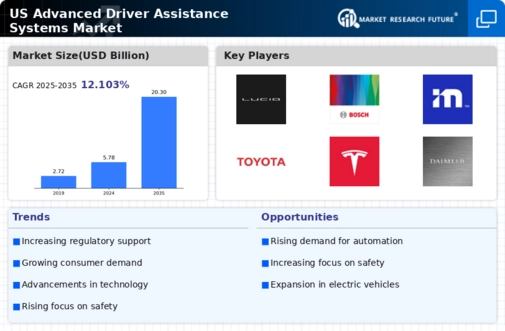Growing Consumer Demand for Safety Features
The advanced driver-assistance-systems market is experiencing a notable surge in consumer demand for enhanced safety features in vehicles. As awareness of road safety increases, consumers are increasingly prioritizing vehicles equipped with advanced safety technologies. According to recent data, approximately 70% of consumers express a preference for vehicles with advanced driver-assistance systems, indicating a strong market inclination towards safety. This trend is further supported by the rising number of road accidents, which has prompted manufacturers to innovate and integrate more safety features into their offerings. Consequently, the advanced driver-assistance-systems market is likely to expand as automakers respond to this growing consumer expectation, thereby driving sales and adoption rates across the industry.
Technological Advancements in Sensor Technologies
Technological advancements in sensor technologies are significantly influencing the advanced driver-assistance-systems market. Innovations in radar, lidar, and camera systems have enhanced the capabilities of these systems, allowing for improved object detection, lane-keeping assistance, and adaptive cruise control. The integration of high-resolution sensors and advanced algorithms has led to a more reliable and efficient operation of these systems. Market data suggests that the adoption of advanced sensor technologies could increase the effectiveness of driver-assistance systems by up to 40%, thereby enhancing overall vehicle safety. As manufacturers continue to invest in research and development, the advanced driver-assistance-systems market is poised for substantial growth, driven by these technological advancements.
Consumer Preference for Connected Vehicle Features
the advanced driver-assistance-systems market is influenced by consumer preference for connected vehicle features. As vehicles become more integrated with digital technologies, consumers are seeking systems that offer connectivity and convenience alongside safety. Features such as real-time traffic updates, remote vehicle monitoring, and smartphone integration are becoming essential for modern drivers. Recent surveys indicate that nearly 60% of consumers are willing to pay a premium for vehicles equipped with advanced connectivity features. This shift in consumer preference is likely to drive the growth of the advanced driver-assistance-systems market, as manufacturers strive to meet these evolving demands and enhance the overall driving experience.
Increasing Regulatory Pressure for Safety Compliance
the advanced driver-assistance-systems market is shaped by increasing regulatory pressure for safety compliance. Government agencies are implementing stricter regulations aimed at enhancing vehicle safety standards, which in turn drives the adoption of advanced driver-assistance systems. For instance, the National Highway Traffic Safety Administration (NHTSA) has proposed new guidelines that encourage the integration of safety technologies in vehicles. This regulatory environment creates a favorable landscape for the advanced driver-assistance-systems market, as manufacturers are compelled to comply with these standards. As a result, the market is likely to witness accelerated growth, with an estimated increase in adoption rates of up to 30% over the next few years as automakers align their products with regulatory requirements.
Rising Investment in Autonomous Vehicle Technologies
the advanced driver-assistance-systems market benefits from rising investment in autonomous vehicle technologies. As automakers and technology companies allocate substantial resources towards the development of autonomous driving capabilities, there is a corresponding increase in the integration of advanced driver-assistance systems. This investment is not only aimed at enhancing vehicle safety but also at improving overall driving experience. Market analysis indicates that investments in autonomous technologies could reach $100 billion by 2030, which will likely bolster the advanced driver-assistance-systems market as these systems serve as foundational elements for fully autonomous vehicles. Consequently, the market is expected to grow as stakeholders recognize the importance of these systems in achieving higher levels of automation.























Leave a Comment